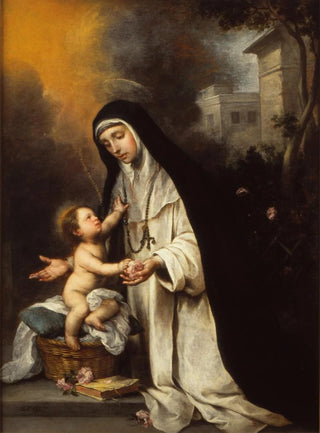Art print | Saint Rose of Lima - Bartolomé Esteban Murillo


View from behind

Frame (optional)
Reproduction Sainte Rose de Lima - Bartolomé Esteban Murillo – Captivating Introduction
The artwork "Sainte Rose de Lima" by Bartolomé Esteban Murillo is a true gem of Spanish baroque painting, transcending the mere scope of religious art. This depiction of the patron saint of the Americas, revered for her devotion and commitment to the less fortunate, evokes an atmosphere of serenity and piety. The artist manages to capture the very essence of holiness through a delicate play of light and soft colors, inviting the viewer to a profound contemplation. In this piece, Murillo does not merely paint a sacred figure; he creates a visual experience that touches both the soul and the spirit.
Style and uniqueness of the artwork
Murillo's style is distinguished by his masterful use of light and shadow, also known as chiaroscuro. In "Sainte Rose de Lima," the light seems to emanate from the saint herself, illuminating her face and garment with an almost celestial softness. The drapery of her robe, in pastel shades, contrasts with the dark background, highlighting the purity and grace of her figure. This chromatic choice, typical of baroque art, creates an atmosphere of mystery and spirituality. The meticulous details, such as the flowers surrounding her, symbols of beauty and fragility of life, add an extra dimension to this piece. Murillo thus succeeds in blending realism and idealization, making the saint accessible while preserving her divine aura.
The artist and his influence
Bartolomé Esteban Murillo, born in Seville in the 17th century, is one of the masters of Spanish painting, whose influence still endures today. His ability to depict religious subjects with such emotion and humanity marked his era and inspired many artists. Murillo established himself with his unique style, which combines deep sensitivity with refined technique. His works, often imbued with softness and tenderness, testify to a profound understanding of human nature and spirituality. Through "Sainte Rose de Lima"

Matte finish

View from behind

Frame (optional)
Reproduction Sainte Rose de Lima - Bartolomé Esteban Murillo – Captivating Introduction
The artwork "Sainte Rose de Lima" by Bartolomé Esteban Murillo is a true gem of Spanish baroque painting, transcending the mere scope of religious art. This depiction of the patron saint of the Americas, revered for her devotion and commitment to the less fortunate, evokes an atmosphere of serenity and piety. The artist manages to capture the very essence of holiness through a delicate play of light and soft colors, inviting the viewer to a profound contemplation. In this piece, Murillo does not merely paint a sacred figure; he creates a visual experience that touches both the soul and the spirit.
Style and uniqueness of the artwork
Murillo's style is distinguished by his masterful use of light and shadow, also known as chiaroscuro. In "Sainte Rose de Lima," the light seems to emanate from the saint herself, illuminating her face and garment with an almost celestial softness. The drapery of her robe, in pastel shades, contrasts with the dark background, highlighting the purity and grace of her figure. This chromatic choice, typical of baroque art, creates an atmosphere of mystery and spirituality. The meticulous details, such as the flowers surrounding her, symbols of beauty and fragility of life, add an extra dimension to this piece. Murillo thus succeeds in blending realism and idealization, making the saint accessible while preserving her divine aura.
The artist and his influence
Bartolomé Esteban Murillo, born in Seville in the 17th century, is one of the masters of Spanish painting, whose influence still endures today. His ability to depict religious subjects with such emotion and humanity marked his era and inspired many artists. Murillo established himself with his unique style, which combines deep sensitivity with refined technique. His works, often imbued with softness and tenderness, testify to a profound understanding of human nature and spirituality. Through "Sainte Rose de Lima"






